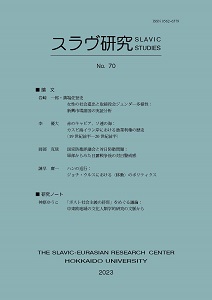ハンの巡行―ジョチ・ウルスにおける〈移動〉のポリティクス
The “Imperial Itinerance” in the Ulus of Jochi
Author(s): Yoichi IsahayaSubject(s): Governance, Political history, 13th to 14th Centuries
Published by: Slavic Research Center
Keywords: nomadic empires; Mongol Empire; khans of the Ulus of Jochi; pastoral economy; Mongol rule;
Summary/Abstract: The nomadic empires—which culminated in the Mongol Empire (1206–1368) in terms of scale—are characterized by high mobility in the sense of constant movement of the power center. In common with most of the khans of the Mongol Empire, the khans of the Ulus of Jochi (Golden Horde) were itinerant monarchs who made seasonal movements especially between winter and summer quarters. Recent scholarly insights have differentiated “imperial itinerance”—whether it be the period of the united empire or later—from “mobile pastoralism” on the grounds that the former was certainly freed from exclusive dependence on the pastoral economy. In the case of Jochid khans, however, a paucity of sources allows us only to glimpse the itineraries of earlier khans like Batu (r. 1227–56) and Berke (r. 1257–66) according to which they engaged in north-south movements along the Lower Volga down to Sarāy in winter and up to Ügek or further to Bulghār in summer. Such seasonal rounds have been deduced from the reports of Latin visitors such as Carpini (ca. 1182–1252), Rubrouck (1215–ca. 65), and Marco Polo (1254–1324) with Arabic geographical description by Abū al-Fidāʾ (1273–1332) and al-ʿUmarī (1301–49). These premises form a research question as to whether, or not, the itineraries of the Jochid khans were fixed along with the Lower Volga without any variety that was well found in cases of other khans’ “imperial itinerance” mainly due to political reasons. To address a variety of itineraries, the travelogue of Ibn Baṭṭūṭa (1304–68 or 77) is worthy of attention. After landing on the Crimea across the Black Sea, he visited the horde of Özbek (r. 1313–41) located near Mājar, a city along the Kuma River in Northern Caucasus in May 1332, ’33, or ’34. As far as extant sources are concerned, Özbek seems not to have been in military operation at that time; rather, Ibn Baṭṭūṭa’s description of the horde shows certain parallels with that of Rubrouck who depicted Batu’s mobile court on his seasonal round. These circumstances enable me to propose the hypothesis that later Jochid khans might have engaged in Volga-Caucasian latitudinal movement as a part of their seasonal rounds with longitudinal movement along the Lower Volga. The aforementioned Latin visitors, who inform us of the itineraries of earlier Jochid khans, did not at all refer to Mājar. Such lack of mention is attributed to the fact that, in the middle of the thirteenth century, mountainous peoples of Caucasus such as the Lezgins fiercely resisted the Mongol rule of this region, which did not ensure the safety of roads, let alone that of khans’ seasonal rounds in Caucasus. However, geopolitical transformation since the reign of Möngke-Temür (1266/67–82) centered Caucasus in Jochid military, diplomatic, and commercial strategies. This transformation came with the rise of Black Sea trade that brought prosperity to cities along commercial roads between the Black Sea and the Caspian Sea. In the reign of Toqto’a (1291–1312) who exerted more direct control over the northerly shores of the two seas, the political situation in Caucasus settled as trade routes were established through the region, which restyled Mājar into a thriving commercial center. The city also commanded a strategic position as a point almost midway between Azov and Derbend, the Iron Gate. Toqto’a must have benefited from the location of Mājar to conduct military operations both to Caffa and Azerbaijan. These facts lead me to conclude that later Jochid khans such as Toqto’a, Özbek, and Janibek (r. 1341–57) had an alternative option, which passed through Northern Caucasus, to that along the Volga in their seasonal rounds. The geopolitical transformation necessitated varying their “imperial itinerance” as in the cases of the other Mongol uluses.
Journal: Slavic Studies
- Issue Year: 2023
- Issue No: 70
- Page Range: 105-136
- Page Count: 32
- Language: Japanese

